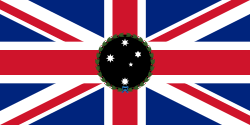 | |
| Use | Civil and state flag |
|---|---|
| Proportion | 1:2 |
| Adopted | 1904 |
| Design | A British blue ensign with the state badge in the fly |
The current state flag of South Australia, was officially adopted in 1904.
Contents
- Design
- Colours
- History
- Previous flags
- Current design
- Proposal for a new flag
- Regulation and use
- Governor's flag
- See also
- References
- External links
The flag is based on the defaced British Blue Ensign with the state badge located in the fly. The badge is a gold disc featuring a piping shrike with its wings outstretched. The badge is believed to have been originally designed by Robert Craig, a teacher at the School of Arts in Adelaide, and officially gazetted on 14 January 1904. [1]






